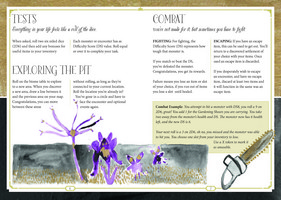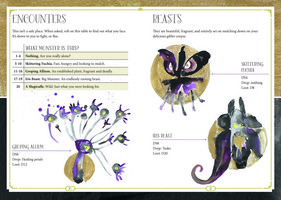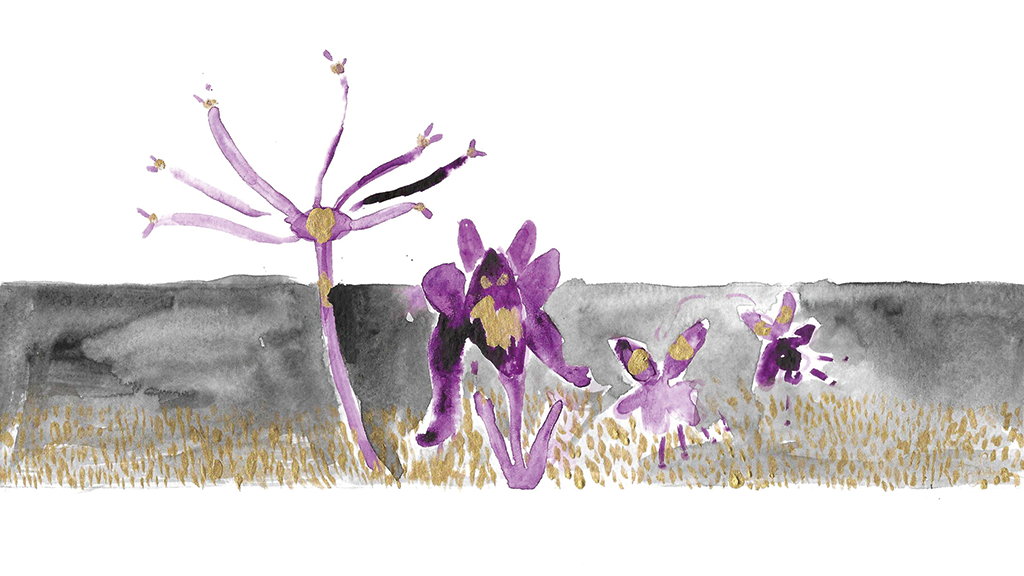The Taming of the Slugiraffe is here, and here's how it went


Hey, I wrote up a few thoughts on substack about the game and the process of making it. You can read it all there, or pasted below:
https://adapressgames.substack.com/p/post-mortem-taming-of-the-slugiraffe?sd=pf
I think our first project is ‘finished’. This was The Taming of the Slugiraffe, a solo pit-crawl game of mapping and survival. Before anything else, you should know that it’s available to buy digitally or review here, and buy in print here.
Later in this post I talk about looking for reviewers and critics, if you are one, do get in touch.
The initial goal of The Taming of the Slugiraffe was to see what it’s like to make a little game and see whether we could get it to Kickstarter, have it fund, and fulfil it.
For those that don’t know me, I am currently the outgoing editor of Tabletop Gaming magazine (which you should check out, even when I am checked out mid-May). It’s the UK’s biggest magazine about board games and roleplaying games, and during my time there I have dedicated substantial pages, time and resources to covering indie titles.
Part of running this campaign and making the game was to understand how crowdfunding really works, and what better way to discover that than to do it? So we did. Here’s how it started.
My partner and I both booked a day off work to sit down and create the bare bones of what would become The Taming of the Slugiraffe. She does the art, I do the words and design. This worked out pretty well honestly, with us both sitting there sketching quick ideas out and writing snippets to build up the idea of what this game would be. While I had the system already in my head (or rather, in a series of drawers, where I keep all my ideas like a pseudo-Knizia), it was through this afternoon of mucking about that we discovered our main character (a giblet) and what its goal was (catching a big slug thing).
The game was to be a light game of random exploration (a bit like Dark Fort, the MÖRK BORG precusor), brutal combat, and a Mausritter-style inventory system. I thought it would probably be 8 pages, 16 if we went a bit mad with the art.
We then set up the Kickstarter, wrote the page, added some pictures and eventually set it live during Zinequest August 2022 (the fake one that Kickstarter moved, remember that?).
I think I did a great job on the Kickstarter description, go take a look here if you’re interested.
I had looked at the money for this all already. A print run would be about £2 per zine at most. I included shipping and packaging on each item that could absorb pretty much any price hike, for example, it was something like $10 for shipping to the USA.
The general wisdom is to not include your shipping on Kickstarter, and instead charge people for it later when you know what it might cost. The benefits to this is you can charge less for your shipping, and hopefully pick up more backers this way.
For me, this was a negative as it was more admin. I didn't want to get into the world of BackerKit and otherpledge managers. There wasn’t going to be add-ons or upsells to do, just the game existing, or not.
One thing I’m quite proud of doing is adding a retail tier to the Kickstarter. This meant that a retailer could pick up ten copies of the game really cheaply. It meant that Knave of Cups and Beyond Cataclysm will eventually have my games on their websites, which I think will feel like having ‘made it’.
We had an original funding goal of £100 to meet. I didn’t realise that all money pledged through Kickstarter would count towards this – i.e. my high cost shipping would help us meet this goal almost immediately. This is probably cheating.
I was also surprised that anyone cared, particularly. It’s a slightly dodgy position to be in: to be professionally writing about games and also ‘asking’ people to promote my Kickstarter. By asking, I mean I did some tweets on my personal account, replied to those ‘drop your project here’ threads, did my own and retweeted everyone involved.
I don’t really know how genuine some of the support was, but I assume mostly. Everyone in indie games is very nice (to a fault, I would suggest) and I think people did want to support the campaign. No one really knows who I am or what I do/did for a living after all. Some kind comments included that this was exactly the kind of project that they wanted to back at ZineQuest – a first time creator who didn’t know what they were doing.
We smashed our goals, and, despite what you’re always told about Kickstarters (you make money in the first and last five minutes) I picked up one or two people a day throughout.
In the end we has raised a very pleasing £1111.
We had £984.90 of that deposited into our account. That felt pretty cool.
We worked out we needed art for each token, and a map. We also realised we needed a real graphic designer.
We realised we needed that part when I showed my designer at the magazine what I’d done so far and he offered to help (mate’s rates, he felt sorry for us I think).
The game was also 20 pages in the end, rather than the expected 16. It’s not loads more, but it’s just something you think you’ve already worked out, which you just haven’t.
We worked as fast as we could. But there were delays.
We had a show at work – a huge and terrifying thing to put together.
My grandmother became ill and, eventually died. I’ll write about this another time. It’s important to know she was a very important person and she was the last thing holding some parts of my family together.
We were sick ourselves too, although we forget this.
The thing with trying to make a game in your spare time is that it really cuts down on the ammount of time you have to spending doing the things you need to do when they come up. You have a to make a choice between getting a silly a little game finished or looking after your three year old daughter, who is very sad about Nan dying. It’s an obvious and easy choice, but you still feel a little bit guilty about everyone waiting for the slug game.
Christmas came and went. We’d more or less finished things by the end of Feburary. We worked on revisions with our designer, who is a busy man.
Eventually the game went to print on 21st March this year. It went out to everyone who backed the game a week or so later. I worked out how to do those itch.io keys and emails, it’s cool there’s so much stuff to support your distribution. It’s all so usefully automated, once you know that it’s there.
The cost of printing came to around £180. Design was at a very charitable £100ish.
We pocketed aroud £450 after the costs of the Kickstarter, production and posting were taken into account.
We spent all of that on our first family holiday (four days in Centre Parcs nearby) since my daughter was born.
Was it worth it?
Yes.
We expected nothing and got to go on holiday, in exchange for mucking about with some words, inks and printers.
I think for those looking at this as a way to support themselves beyond helpful pocket money (if we’d had a big bill come in, then I think this would have been swallowed up by that, and we’d not get a holiday at all) should probably look to others for advice. The recent Batts piece on the remastered version of .dungeon might be useful, or just read Daniel Sell’s blog (which is where the most actionable parts of Batts piece can be traced to).
I did help one creator during their Zinequest Kickstarter rewrite their page however (we just got chatting, they asked!)
I’d be happy to offer that advice again, should someone need it. Their game was a quite jolly one with a good concept, clear artwork and direction, a good theme – and then the actual page text was a little confused and meandering. If I would offer any advice at all it would be to make your Kickstarter page:
- Really clear and obvious about what the backer is getting from the start. You need to say ‘this is a game which will make you feel like this, remind you of this, and take you on this journey’ before anything else. For example, we used the classic ‘meets’ formula, “It’s dark souls, but you’re a pikachu looking for a snorlax”. You might consider this a bit rubbish in terms of the quality of the writing – but it gives a very clear picture.
- Provide a clear description of what the book gives them and how it’s going to achieve the above vision of play. For us, that was explaining the systems used and how they combined (start trying to survive, having to switch into non-lethal equipment)
- Don’t explain how the game works in any detail. No one really cares how the game works when they’re reading a Kickstarter page, and anything that reads like rules will turn people off. It’s chill, people are here for a dream, not why your D120 system is great. It might be, but we can work that out later.
That aside, I’d like to talk about this little wasteland beyond that we’re currently experiencing now. The game is out in the world with the people who back it (thank you, people!). We have set up a free website for selling the game for those who missed out (those links at the top).
Both my partner and I have worked in marketing before. It's really boring and we don’t really want to be out there running adverts or anything for our games. We’re working on the next thing, we don’t want a business.
We wonder if we should take a stand at a convention to shift a few of the copies we have left. But I think that’s something you can only really do when you have a couple of games under your belt (and on your table). I’d like to have a table at Dragonmeet one year.
So, after the hype of the Kickstarter itself, and the relief of fulfilment, we wonder what to do next. It’s a bit weirdly empty, which I think is what people talk about when they publish a novel and the world doesn’t change. It’s changed for us, of course, and that is enough for now.
I have been sending out copies to reviewers who might be interested (and, in fact, if you are one, please let me know, you’re welcome to a PDF or hard copy) and I think that should be the extent of our ‘marketing’ or ‘outreach’.
I used to talk to a friend of mine about writing and how there’s this hierarchy of satisfaction from your writing. There’s the writing itself, and then being published, and then being actually read, and then reviewed, and then being studied and finally being taught and referenced.
A writer called Will Buckingham added to this with his notion that there’s a stage higher than this, which he experienced with one of the children’s books he had written. He was invited to a school because the children had been assigned the book for a project that term. The book is about a dog that goes to space (or something, sorry Will!). Each child was asked to create something around the stories within the book. And so he walked into a school hall filled with papier mache versions of scenes from his stories, models of the dog, or the spaceship, a moon landing or otherwise.
That, he said, was satisfaction from writing.
I think that games can offer something a bit like that. If someone can turn around to me in a couple of years and say “Oh, that silly little slug game, I played it 20 times, loved it. Laminated the pieces and tweaked the rules,” that would be the peak of writing satisfaction. For me, at least.
Thanks then, again, to everyone who backed the game. And thanks to you for reading this. I think it’ll be useful to look back at once we’ve done a few more.
Files
Get THE TAMING OF THE SLUGIRAFFE
THE TAMING OF THE SLUGIRAFFE
a solo pit-crawl in search of an ancient beast
| Status | Released |
| Category | Physical game |
| Author | Ada Press |
| Genre | Adventure |
| Tags | mapmaking, Solo RPG, Tabletop role-playing game |
More posts
- SO, YOU LIKE MONSTERS?Feb 09, 2024
- We're on Board Game Geek, We're on Youtube, We're in your shed tangling up your...Apr 21, 2023

Leave a comment
Log in with itch.io to leave a comment.